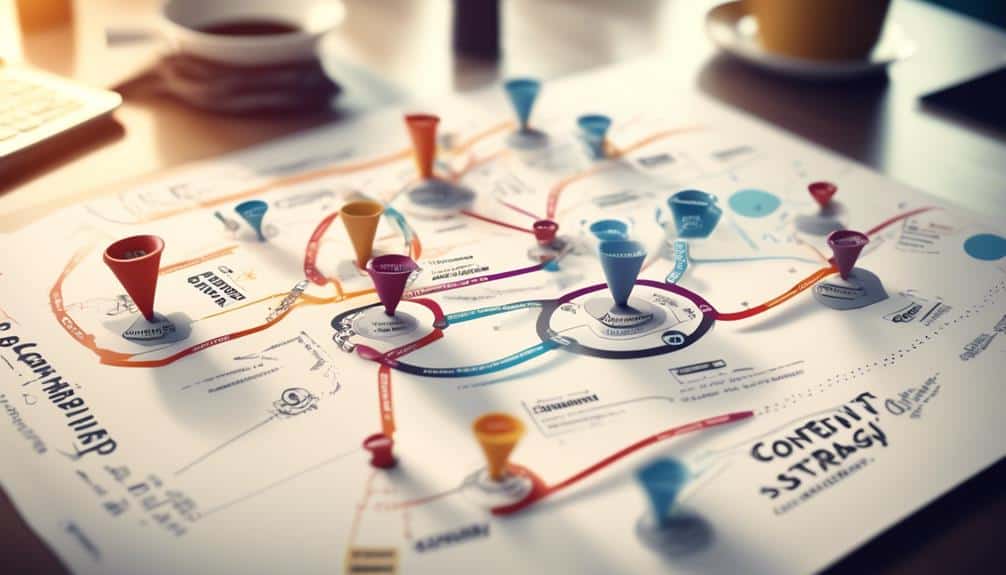Aligning Content With Business Goals: a Roadmap to Roi-Driven Marketing
When navigating the landscape of aligning content with your business goals, envision your strategy as a compass pointing towards the ROI-driven destination.
Each step in this roadmap serves as a crucial milestone in achieving marketing success that resonates with your bottom line.
As you embark on this journey, the convergence of content and business objectives holds the key to unlocking a realm of possibilities that can elevate your brand to new heights.
Key Takeaways
- Set clear, measurable objectives aligned with business goals for maximizing ROI.
- Conduct thorough market research to identify target audience demographics and preferences.
- Craft a data-driven content strategy focused on continuous improvement based on audience insights.
- Utilize performance metrics for tracking engagement levels and optimizing content for maximum ROI.
Setting Clear Objectives

To maximize ROI in your marketing efforts, setting clear and measurable objectives is crucial for aligning content with business goals. Goal setting and KPI tracking are essential components in this process. By defining specific objectives that are aligned with your business goals, you create a roadmap for success. These objectives should be measurable, allowing for ROI analysis to determine the effectiveness of your marketing strategies.
When setting your objectives, consider how they align with the overall goals of your business. This objective alignment ensures that every piece of content you create serves a specific purpose in driving towards your desired outcomes. Regular KPI tracking is necessary to monitor the progress towards these objectives and make data-driven decisions to optimize your marketing efforts.
Incorporating ROI analysis into your goal setting process allows you to continuously evaluate the impact of your content on your business objectives. By setting clear objectives, tracking KPIs, and analyzing ROI, you can ensure that your marketing efforts are driving tangible results for your business.
Identifying Target Audience
Identifying your target audience is a foundational step in crafting effective marketing strategies aligned with your business goals. By conducting thorough market research, you can pinpoint the demographics and preferences of your potential customers. Utilizing demographic profiling and audience segmentation allows you to tailor your content to specific groups, increasing engagement and conversion rates.
Key Strategies for Identifying Target Audience:
| Strategies | Description | Benefits |
|---|---|---|
| Demographic Profiling | Analyzing age, gender, location, income, etc. | Personalized targeting |
| Audience Segmentation | Grouping individuals based on behavior, interests, etc. | Tailored content |
| Persona Creation | Developing fictional characters representing target segments | Humanizes data |
| Market Research | Gathering data on market trends, competitor activity, etc. | Informed decision-making |
Content Strategy Development

Crafting a data-driven content strategy is crucial for aligning your marketing efforts with your business goals and maximizing ROI. To develop an effective content strategy, begin by focusing on content optimization. This involves analyzing your existing content, identifying what works best for your audience, and leveraging data to enhance the performance of your content. By continuously refining and improving your content based on data insights, you can ensure that your content remains relevant, engaging, and impactful.
Another key aspect of content strategy development is audience segmentation. By dividing your target audience into specific segments based on demographics, behavior, or preferences, you can create tailored content that resonates with each group. This personalized approach not only increases the effectiveness of your content but also strengthens your relationship with your audience.
Incorporating content optimization and audience segmentation into your content strategy won't only drive better results but also help you achieve your business objectives more efficiently. Stay focused on refining your strategy based on data and audience insights to continuously improve your content's performance and drive ROI.
Measuring Performance Metrics
To effectively gauge the success of your content strategy, it's crucial to track conversion rates and analyze engagement levels. By measuring these performance metrics, you can gain valuable insights into how well your content is resonating with your target audience and driving desired actions.
Utilize these data points to make informed decisions and optimize your content for maximum ROI.
Tracking Conversion Rates
To optimize your marketing efforts effectively, track conversion rates consistently and align them with your business objectives for higher ROI. When it comes to tracking conversion rates, consider the following key strategies:
- Implement Conversion Optimization Techniques: Utilize A/B testing to experiment with different elements on your website and determine which versions lead to higher conversion rates.
- Enhance Landing Page Performance: Focus on landing page optimization to ensure that your pages are designed to guide visitors towards conversion actions effectively.
- Analyze Call to Action Effectiveness: Conduct in-depth analysis of your call to action buttons to see which ones generate the most clicks and conversions, allowing you to refine and improve their performance.
Analyzing Engagement Levels
Analyzing engagement levels allows you to measure the performance metrics that directly impact your conversion rates and overall ROI. By delving into engagement analysis and understanding audience behavior, you can optimize your content strategy for maximum effectiveness. Below is a table highlighting key metrics to track for a comprehensive analysis:
| Metric | Description | Importance |
|---|---|---|
| Bounce Rate | Percentage of visitors who navigate away without interaction | Indicates content relevance |
| Time on Page | Average time visitors spend on a page | Reflects content engagement |
| Click-Through Rate | Percentage of users clicking on a specific link | Measures call-to-action effectiveness |
Aligning Content With Sales Funnel

Incorporating content strategically throughout the sales funnel can significantly impact conversion rates and drive ROI for your business. To ensure your content is effectively aligned with your sales funnel, consider the following:
- Content Alignment: Tailor your content to match the specific stages of the sales funnel. Create awareness-focused content for the top of the funnel, educational content for the middle, and decision-oriented content for the bottom.
- Sales Funnel Mapping: Conduct a thorough analysis of your sales funnel to understand where prospects might drop off or need additional information. Map out content that addresses these pain points and guides leads towards a purchase.
- Personalization Strategies: Utilize data-driven insights to personalize content for different segments within your sales funnel. Personalization can improve engagement and conversions by delivering the right message to the right audience at the right time.
Leveraging SEO Techniques
Implementing SEO strategies is essential for maximizing online visibility and driving organic traffic to your website. To leverage SEO techniques effectively, focus on link building and keyword research. Link building involves acquiring quality backlinks from reputable sites to boost your site's authority and credibility in the eyes of search engines. Keyword research is about identifying the terms and phrases your target audience is searching for so you can optimize your content accordingly.
Leveraging SEO Techniques
Implement the following strategies to enhance your SEO efforts:
| Strategy | Description | Benefits |
|---|---|---|
| Link Building | Acquire backlinks from authoritative sites to improve your site's credibility. | Higher search engine rankings |
| Keyword Research | Identify relevant search terms to optimize your content and improve search visibility. | Targeted traffic to your website |
Utilizing Data Analytics Tools

You need to harness the power of data analytics tools to drive your content strategy forward.
By making data-driven decisions, you can gain valuable insights that will guide your marketing efforts towards achieving your business goals.
Utilize analytics to measure the impact of your content and optimize your ROI effectively.
Data-Driven Decision Making
Utilizing advanced data analytics tools enables businesses to make informed decisions that drive measurable ROI and align content with strategic objectives. Data-driven decision making is crucial in today's fast-paced digital landscape.
Here's how you can leverage data analytics tools effectively:
- Implement Predictive Analytics: Forecast trends and customer behavior to proactively adjust your content strategy.
- Utilize A/B Testing: Experiment with different content variations to see what resonates best with your audience.
- Track Key Performance Indicators (KPIs): Monitor metrics like conversion rates, engagement levels, and customer lifetime value to optimize content performance.
Analytics for Insights
To drive strategic decision-making and achieve measurable ROI, businesses must harness the power of data analytics tools for gaining valuable insights that shape content alignment with business goals. By leveraging predictive modeling and customer segmentation, you can dive deep into understanding consumer behavior patterns, preferences, and trends. These insights enable you to create targeted content that resonates with specific audience segments, ultimately driving higher engagement and conversion rates. The table below highlights the key benefits of utilizing data analytics tools for content alignment:
| Benefits of Data Analytics Tools |
|---|
| Enhanced Customer Understanding |
| Improved Personalization Efforts |
| Increased Marketing Effectiveness |
Integrating Social Media Channels
Maximizing the reach and impact of your marketing efforts necessitates a cohesive strategy for integrating various social media channels. To effectively integrate social media channels into your marketing strategy, consider the following:
- Cross-Platform Consistency: Ensure that your brand messaging and visuals are consistent across all social media platforms. This consistency helps reinforce brand recognition and maintain a unified brand image.
- Data-Driven Decisions: Utilize analytics tools to track the performance of your social media content. Analyzing metrics such as engagement rates, click-through rates, and conversions can provide valuable insights to optimize your social media strategy for better results.
- Strategic Influencer Collaborations: Identify influencers in your industry whose audience aligns with your target market. Collaborating with influencers can help increase brand awareness, drive social media engagement, and create authentic connections with potential customers.
Collaborating With Sales Team

To fully align content with business goals, start by collaborating closely with your sales team. By fostering a strong partnership, you can ensure that content strategies are tailored to support sales objectives effectively.
Implement targeted messaging strategies and data-driven sales enablement tools to optimize the sales process and drive ROI.
Sales Team Alignment
Collaborating effectively with the sales team is integral to achieving measurable ROI in marketing efforts. To ensure successful sales team alignment, consider the following strategic steps:
- Implement Sales Enablement Tools: Equip your sales team with the necessary technology and resources to streamline their processes and enhance productivity.
- Establish Clear Communication Strategies: Foster open lines of communication between the marketing and sales departments to ensure alignment on goals and messaging.
- Provide Ongoing Training and Support: Continuously invest in training programs to keep the sales team updated on new marketing strategies and product knowledge, enabling them to better represent your brand.
Targeted Messaging Strategies
To optimize the impact of your marketing efforts and enhance sales team alignment, crafting targeted messaging strategies is crucial for driving ROI and maximizing business results.
By implementing personalized messaging based on audience segmentation, you can increase engagement and conversions. Collaborating with the sales team to understand customer pain points and preferences allows for tailored content that resonates with specific segments of your target market.
Utilizing data-driven insights to refine these strategies ensures that your messaging remains relevant and effective. This targeted approach not only increases the likelihood of capturing the attention of potential customers but also strengthens the connection between marketing initiatives and sales outcomes.
Embracing personalized messaging through audience segmentation is a key driver in achieving marketing goals and boosting overall ROI.
Data-driven Sales Enablement
For optimal alignment with business objectives and enhanced sales performance, establish data-driven sales enablement practices through close collaboration with your sales team. To boost sales effectiveness and drive revenue growth, focus on data optimization strategies that leverage insights for targeted sales efforts.
Here's how to excel in data-driven sales enablement:
- Implement AI-Powered Sales Tools: Utilize artificial intelligence to analyze customer data, predict buying behavior, and personalize sales interactions.
- Create Integrated Data Platforms: Integrate all sales and marketing data to provide a comprehensive view of customer interactions and preferences.
- Enable Real-time Sales Insights: Develop systems that offer real-time data on customer engagement, enabling sales teams to adjust strategies instantly for better results.
Continuous Optimization Strategies

Implementing a dynamic approach to refining and enhancing marketing strategies is crucial for maximizing ROI and achieving sustainable growth. Continuous optimization strategies are essential for staying ahead in today's competitive landscape. By utilizing A/B testing strategies and conversion rate optimization, you can fine-tune your content to resonate with your target audience effectively.
Analyzing user experience metrics and implementing content personalization based on data insights can significantly impact engagement and conversion rates.
To drive innovation and achieve superior results, it's vital to constantly iterate and improve your marketing approach. Monitor key performance indicators closely, identify areas for enhancement, and test different variations to see what resonates best with your audience. By embracing a data-driven mindset and focusing on goal-oriented strategies, you can adapt to changing market dynamics and consumer preferences swiftly.
Frequently Asked Questions
How Can Businesses Ensure That Their Content Aligns With Current Market Trends and Consumer Preferences?
To ensure your content aligns with market trends and consumer preferences, conduct market research and analyze consumer behavior. Optimize your content based on trend analysis data. Stay ahead by continuously adapting to changing consumer needs.
What Role Does Brand Storytelling Play in Effectively Aligning Content With Business Goals?
Brand storytelling plays a crucial role in aligning content with business goals. It impacts brand engagement, fosters emotional connections, and drives consumer loyalty. By crafting compelling narratives, you can create a distinct identity that resonates with your audience.
How Can Businesses Determine the Most Effective Channels for Distributing Their Content to Reach Their Target Audience?
To determine the most effective channels for distributing content and reaching your target audience, focus on channel optimization through data-driven insights. Identify your audience through precise targeting and tailor your marketing strategy for optimal content distribution success.
What Are Some Common Challenges Businesses Face When Measuring the ROI of Their Marketing Efforts?
When measuring effectiveness, businesses often struggle with data analysis challenges. It can be daunting to interpret and derive actionable insights from the metrics gathered. Overcoming these hurdles is vital for maximizing ROI in marketing efforts.
How Can Businesses Effectively Leverage User-Generated Content to Enhance Their Marketing Strategies and Align With Their Business Goals?
To enhance marketing strategies and align with business goals effectively, leverage influencers and focus on social media engagement. By tapping into user-generated content, you can create authentic connections, drive brand awareness, and boost ROI.
Conclusion
In conclusion, by aligning your content with your business goals, you can drive ROI and achieve success in your marketing efforts.
Setting clear objectives, identifying your target audience, and utilizing data analytics tools are key strategies to ensure your content is effective.
By continuously optimizing and collaborating with your sales team, you can maximize the impact of your content throughout the sales funnel.
Stay focused, data-driven, and goal-oriented to see the results you desire.








